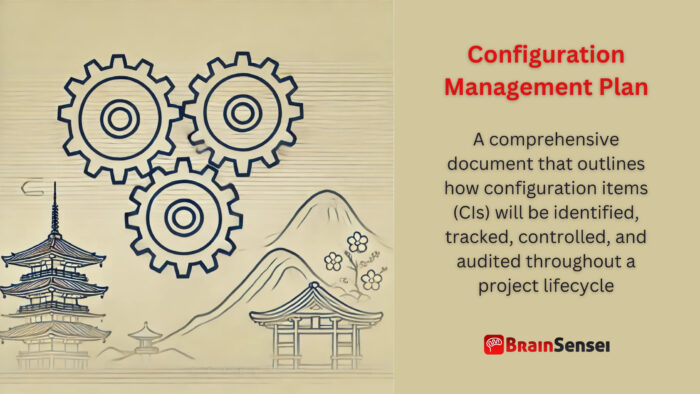
Configuration Management Plan
What is a Configuration Management Plan?
A configuration management plan (CMP) is a comprehensive document that outlines how configuration items (CIs) will be identified, tracked, controlled, and audited throughout a project lifecycle. It ensures that project artifacts, documentation, and deliverables remain consistent, accurate, and up-to-date. This plan is essential in industries where product integrity and traceability are critical, such as aerospace, software development, and construction.
Key Takeaways
- Centralized Documentation: Provides a single source of truth for configuration management activities.
- Traceability: Tracks changes to project components, ensuring accountability.
- Consistency: Maintains the integrity of project deliverables.
- Risk Mitigation: Reduces risks associated with uncontrolled changes.
- Compliance Assurance: Helps meet industry standards and regulatory requirements.
Understanding the Configuration Management Plan
How It Works
The CMP establishes guidelines for managing configuration items throughout a project’s life cycle. This plan includes defining roles and responsibilities, establishing baselines, and detailing the tools and processes for change control and audits.
- Identification: Cataloging all configuration items with unique identifiers.
- Control: Implementing procedures for requesting, evaluating, and approving changes.
- Status Accounting: Recording and reporting the status of configuration items.
- Verification and Audit: Ensuring compliance through regular reviews.
Important Considerations
- Regular Updates: Update the CMP as the project evolves.
- Tool Selection: Choose tools that align with project needs.
- Role Clarity: Clearly define responsibilities within the configuration management team.
- Change Management Integration: Align with the project’s overall change management processes.
- Training Requirements: Train all team members on CMP protocols.
Related Terms
- Change Management Plan: A plan that defines how changes will be managed and controlled throughout the project.
- Baseline: A reference point for project scope, schedule, or cost.
- Configuration Item (CI): An item subject to configuration management.
- Version Control: A system that tracks revisions and changes to project documents and code.
- Audit: A systematic review to ensure compliance with the configuration management process.
- Configuration Control Board (CCB): A group responsible for reviewing and approving changes.
Examples of Configuration Management Plan Across Industries
Manufacturing Industry
In a manufacturing firm producing medical devices, a CMP ensures that design specifications, production processes, and regulatory documentation are consistently maintained. The plan, which requires formal approval from a Configuration Control Board (CCB) for design changes, facilitates regulatory audits by enabling traceability from the initial design to the final product. For instance, when an engineer proposes a design alteration for a new type of insulin pump, the CMP outlines the necessary steps: submitting a change request, assessing potential impacts, conducting tests, and obtaining approval before implementation. This process prevents unapproved modifications that could jeopardize patient safety or regulatory compliance.
Additionally, the CMP specifies documentation requirements for each stage of production, ensuring thorough documentation of changes to assembly processes. This traceability is crucial for post-market surveillance, enabling the company to identify and address issues arising after the product’s release.
IT & Software Development
A software development company uses a CMP to manage source code, libraries, and documentation. The plan outlines how changes to the codebase are requested, tested, and approved. Automated tools like Git are used for version control, ensuring multiple teams work on different features without conflicts. For example, when a product owner requests a new feature for a customer relationship management (CRM) application, the CMP defines the procedures for submitting a change request, conducting code reviews, and performing automated tests.
The plan also mandates regular audits of the code repository to identify unauthorized changes or potential security vulnerabilities. Additionally, the CMP facilitates collaboration among distributed teams by establishing clear guidelines for merging code changes. This structured approach minimizes integration issues and ensures the software remains stable and maintainable as it evolves.
Aerospace & Defense
A CMP ensures that engineering designs, testing protocols, and operational documentation adhere to strict regulatory standards in aerospace projects. The plan includes regular audits and detailed status accounting to track configuration changes across different systems and components. For instance, when developing a new avionics system for a commercial aircraft, the CMP specifies the procedures for validating hardware and software components.
The plan requires comprehensive documentation of design changes and rigorous testing to verify performance and safety. This documentation is critical for obtaining certification from aviation authorities like the FAA or EASA. Furthermore, the CMP includes protocols for managing supplier configurations, ensuring that components from different vendors comply with the project’s specifications. Regular audits are a key part of this, ensuring ongoing compliance with industry standards.
Moreover, the aerospace industry often involves long product lifecycles, making configuration management an ongoing activity. The CMP addresses this by establishing processes for maintaining configuration records over extended periods facilitating maintenance, upgrades, and incident investigations throughout the aircraft’s operational lifespan.
These detailed examples demonstrate how the Configuration Management Plan is a foundation for consistency, quality, and compliance across diverse industries.
Use Cases of Configuration Management Plan
United States (Healthcare IT Project)
A hospital in California implements a CMP to manage its electronic health records (EHR) system. The plan specifies procedures for updating patient record software while ensuring compliance with HIPAA regulations. Regular audits and staff training sessions ensure that changes do not compromise data integrity. The plan details how configuration baselines for patient records must be maintained, with stringent access controls to prevent unauthorized changes. Additionally, it outlines the process for implementing software updates, which includes risk assessment, validation testing, and rollback procedures in case of failures.
This CMP also includes protocols for integrating new modules, such as a telemedicine feature, without disrupting existing functionalities. Through regular audits, the hospital ensures its system remains compliant with healthcare regulations while maintaining high availability for medical staff who rely on the EHR system for critical decisions.
Germany (Construction Project)
A construction company in Berlin adopts a CMP for a large commercial building project. The plan tracks design documents, material specifications, and structural changes. By integrating the CMP with Building Information Modeling (BIM) software, the project team ensures alignment between design updates and construction activities. The plan specifies procedures for submitting design changes, conducting structural analyses, and obtaining approvals before implementation.
During construction, the plan helps manage the impact of unforeseen issues, such as material shortages or design modifications, by providing a structured process for evaluating and implementing necessary changes. This adaptability is a key feature of the CMP in the construction industry.
The company also conducts regular audits to verify compliance with local building codes and safety standards. This proactive approach minimizes the risk of errors and delays, contributing to the project’s successful completion within budget and schedule.
India (Telecommunications Project)
A telecom provider in India uses a CMP to manage network infrastructure upgrades. The plan standardizes configuration management across different regions, enabling efficient rollout of new technologies while minimizing service disruptions. For instance, when upgrading network equipment to support 5G technology, the CMP specifies the procedures for installing, configuring, and testing new hardware.
The plan also includes guidelines for coordinating with third-party vendors, conducting performance tests, and documenting network configurations. The company can quickly diagnose and resolve connectivity issues by maintaining accurate records of configuration changes. Additionally, the CMP helps ensure compliance with national telecommunications regulations, supporting the company’s long-term growth and reliability.
These use cases highlight how a well-structured Configuration Management Plan can enhance operational efficiency, regulatory compliance, and service quality across diverse industries.
Best Practices for Configuration Management Plan Implementation
Successful implementation of a Configuration Management Plan requires more than just defining processes; it involves a continuous commitment to best practices. Here are key strategies.
Define Clear Objectives
Establish specific goals for configuration management. Objectives should align with broader project objectives to ensure relevance and effectiveness. Clear objectives help teams understand the importance of configuration management and guide decision-making.
Standardize Processes
Utilize established frameworks like ITIL or ISO 10007. Standardization ensures consistency across teams and projects, reducing confusion and errors. Document all processes to provide clear guidelines for team members.
Use Automation Tools
Leverage tools such as Ansible, Puppet, Jenkins, and Git. Automation minimizes manual tasks, reduces human error, and enhances efficiency. Select tools that integrate well with existing systems and provide robust reporting capabilities.
Conduct Regular Audits
Schedule periodic reviews to ensure compliance with standards and identify potential issues. Audits should evaluate documentation accuracy, process adherence, and the effectiveness of implemented changes.
Ensure Team Collaboration
Promote communication between departments. Configuration management often intersects with various project areas, making collaboration essential. Use tools like Slack, Microsoft Teams, and JIRA to facilitate communication.
Train Personnel
Provide regular training sessions. Team members must understand the configuration management principles and the plan’s specifics. Training ensures consistent application of processes and prepares the team for changes.
Monitor Performance Metrics
Establish key performance indicators (KPIs) to evaluate configuration management activities. Metrics include the number of change requests processed, the time it takes to approve them, and the frequency of audit findings.
Document Everything
Maintain comprehensive records of all configuration items, processes, and changes. Documentation supports accountability, facilitates audits, and provides a knowledge base for future projects.
Neglecting these practices can result in uncontrolled changes, inconsistent documentation, and compliance issues.
Common Mistakes and Issues
Configuration management plans often encounter challenges that can disrupt projects if not addressed proactively. A common issue is treating configuration management as a one-time rather than an ongoing process. For example, a software firm failed to update its CMP after a major system upgrade, leading to deployment errors and project delays. Additionally, a lack of personnel training can cause misunderstandings and mistakes when implementing configuration changes. Miscommunication between teams is another frequent pitfall, as configuration management requires cross-departmental collaboration. Continuous monitoring, regular training, clear documentation, and open communication channels are essential to avoid such pitfalls. Ignoring these factors can lead to increased costs, reduced efficiency, and non-compliance with industry standards.
Frequently Asked Questions (FAQs)
What is the primary purpose of a Configuration Management Plan?
The primary purpose is to ensure that project configuration items are accurately documented, controlled, and maintained throughout the project lifecycle.
How does a Configuration Management Plan differ from a Change Management Plan?
A CMP focuses on tracking and controlling project configurations, whereas a Change Management Plan manages how changes are introduced and implemented.
Who is responsible for the Configuration Management Plan?
Typically, a Configuration Manager oversees the plan, with support from the Configuration Control Board (CCB) and project team.
What tools do project teams use for Configuration Management?
Popular tools include Git, Jenkins, Ansible, Puppet, and ServiceNow.
When should a Configuration Management Plan be updated?
The CMP should be updated whenever there are significant project changes, such as scope adjustments or new regulatory requirements.
Additional Resources
Preparing for a PMI certification?
- Exam Prep Courses: PMP®, CAPM®, and PMI-ACP®
- Exam Simulators: PMP®, CAPM®, PMI-ACP®, PMI-PBA®, PMI-RMP®, PMI-SP®, PgMP®, and PfMP®
- Professional Development Units (PDUs): 15, 30, and 60 PDU Bundles



